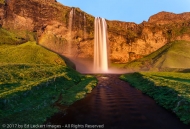

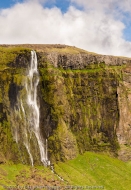
The Native American name “Hoh” means “fast white woman” – uh, water – I meant to say “fast white water”! Anyway, who wouldn’t want to visit a place with fast white water!
OK, full disclosure: that meaning of the name was attributed by Smitty Parratt in his book Gods & Goblins: A Field Guide to Place Names of the Olympic National Park, though other sources argue that there is no basis for this claim. History is such a fuzzy subject sometimes.
Anyway, the Hoh Rain Forest sits on the western side of the Olympic Peninsula in the Olympic National Park. Speaking of fuzzy, moss-covered Sitka spruce and western hemlock that are hundreds of years old and up to 250 ft. (76 m.) tall occupy this forest, along with other conifers and deciduous species.
The Olympic National Park was established in 1938, and in 1988, 95% of the park or 1,370 square miles was designated as a protected wilderness area. The park encompasses three distinctly different ecosystems: rugged glacier-capped mountains, wild Pacific coast, and magnificent old-growth temperate rain forests. Today we’ll focus on one rain forest in the park, the Hoh Rain Forest in the Hoh River Valley.
The Hoh is a Temperate Rain Forest, unlike the jungle rain forests which are Tropical Rain Forests. You won’t find any macaws or poison dart frogs here, but you will find the largest unmanaged herd of Roosevelt elk in the world. In fact, the park was almost named Elk National Park. I saw elk every time I hiked along the trails in the Hoh River Valley.
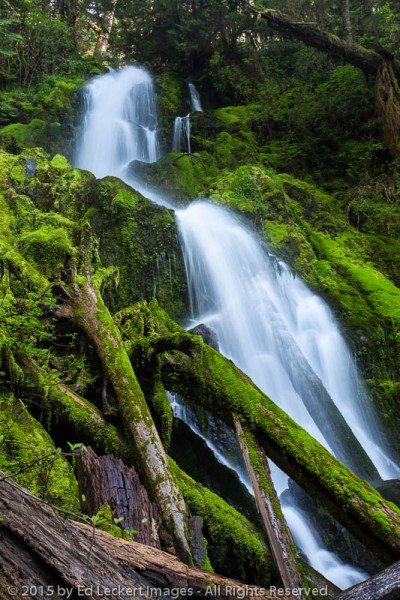
Water cascades down Mineral Creek Falls before joining the Hoh River, in Olympic National Park, Washington.
The Hoh Rain Forest is reached via the Upper Hoh Road off of US Hwy 101, about 20 miles (32 km.) south of Forks, Washington, and just over four hours from Seattle. The road leads to the Hoh Rain Forest Visitor Center, which right now is a sad little trailer parked in the parking lot while the real visitors’ center is renovated. It seems all the parks are getting ready for the 100th anniversary of the National Park Service in August of 2016, so everybody’s getting a facelift. A year-round campground is also located here, making this the perfect base for exploring the area.
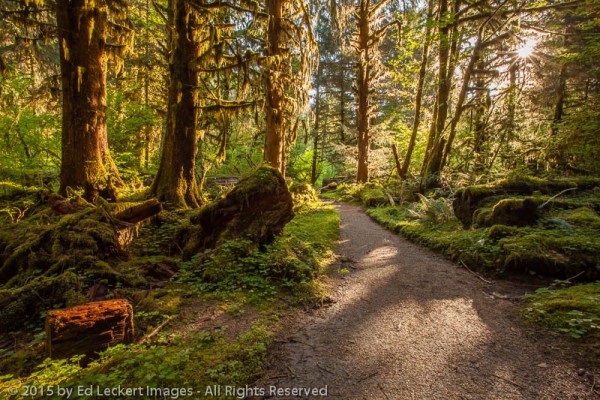
The Hoh River Trail offers a peaceful morning hike through the rainforest, in the Olympic National Park, Washginton.
There are several loop trails near the Visitors’ Center that highlight the features of the rain forest. The predominant trees here are the Sitka spruce and the western hemlock, although some Douglas firs have managed to fight their way through the jungle of understory to eek out a living. Vine maple is the dominant deciduous tree here. A large percentage of the trees are draped in mosses that feed off of water and nutrients they gather from the air without harming their host trees at all.
One theme that plays out over and over is the role of the nurse log in launching new trees. The ground is so cluttered with vegetation that getting enough light to photosynthesize is difficult to impossible for new seedlings. Fallen trees give them just enough of a boost to survive and thrive in this competitive environment. Long after the nurse log has rotted away, trees that grew up on that log will be lined up in a row, sometimes with roots suspended high in the air where the log once sat.
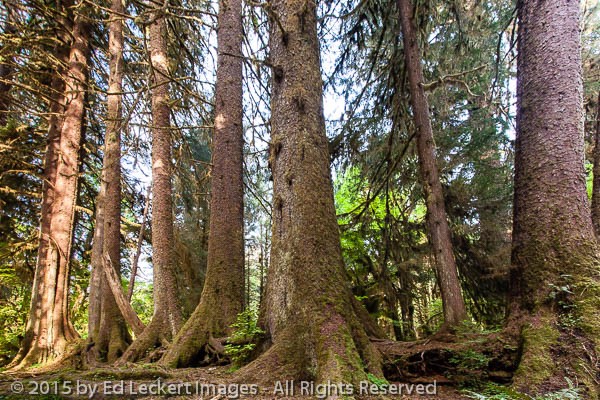
A row of Sitka spruce and western hemlock trees has survived by sprouting from a fallen tree that has become their nurse log, in Olympic National Park, Washington.
The Hoh River Trail is the main trail leading from the area. The trail meanders through old growth rain forest along the Hoh River for 17.4 miles (28 km.) to Glacier Meadows. A number of backcountry campsites lie along the trail, but the main objective for climbers is Mount Olympus. This is a technical climb, so don’t even think about it.

A sign at the Hoh River Trail trailhead shows the distances to various locations along the trail, at Olympic National Park, Washington.
The source of the Hoh River is meltwater from the Hoh Glacier on the northeast side of Mount Olympus. As a result, the Hoh is full of sediment that turns it a milky white color. If you decide to backpack along the Hoh River Trail, it is recommended that you don’t filter water from the Hoh River, as the tiny particles can easily clog a water filter. Use one the many side creeks instead.

This abstract of the Hoh River accentuates the blue color of the reflected sky as the river rages past, in the Olympic National Park, Washington.
Hiking the Hoh River Trail in early May, I saw numerous varieties of wildflowers along the edge of the trail, including the ubiquitous buttercup. In a future article I’ll feature some of the other varieties of wildflowers found here.
So that’s the Hoh. This time of year it’s not crowded at all, even on the weekends, so if you live in the Seattle area, take advantage of the serenity it offers and take that well deserved break! Visit the Hoh!

As always, beautiful! The abstract of the water looks like a painting.
Thanks, Catherine! That’s what I was going for.